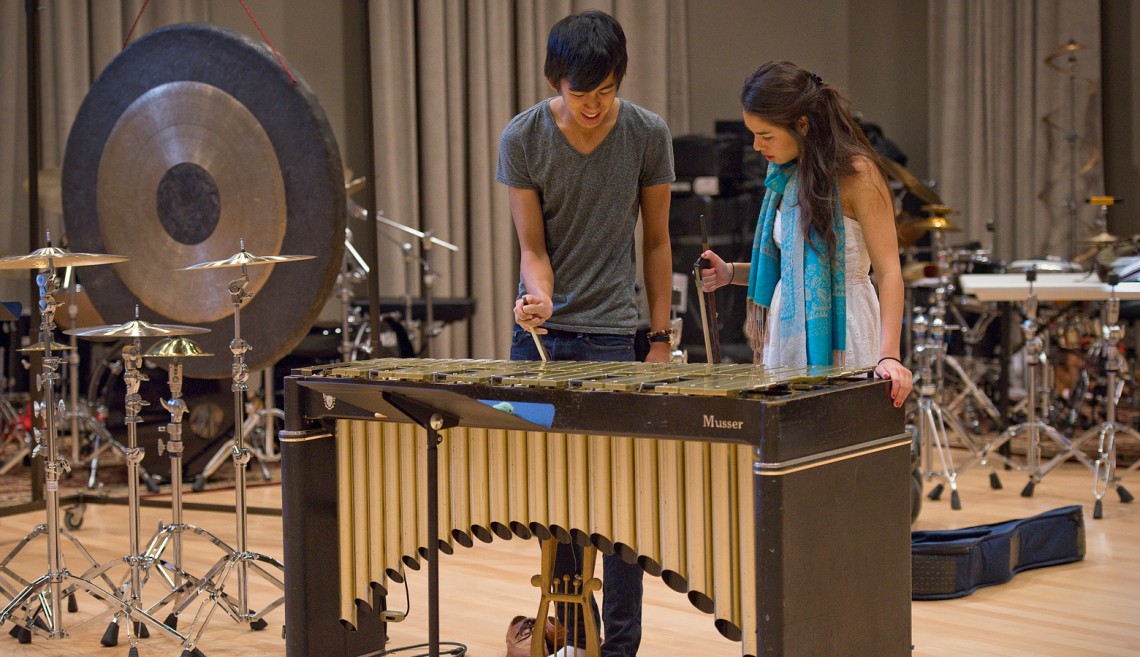
Sophomore Kenneth Qin and Junior Tina Miller experiment with the use of a violin bow on the bars of the vibraphone.
L.A. CiceroStanford students’ variations on a theme by Kotche
Percussionist Glenn Kotche – solo performer, composer and drummer for the rock band Wilco – preceded his Saturday night concert with a creative workshop for Stanford performance artists.
A Glenn Kotche performance is a physically impressive feat. Kotche is a percussionist – best known as the drummer for the rock band Wilco – renowned for his solo percussion shows. Without melodies and harmonies to hide behind, these concerts leave him with the task of making a seamless, full composition out of what seems like sheer will.
This means a kind of alchemy: tremendous displays of exertion on his part are converted into a highly conceptual experience for the listener. Wide-ranging references to stories, visual art, natural soundscapes – all are expressed in the most abstract style possible.

L.A. Cicero
These elements were on offer Saturday night at Bing Concert Hall during an all-percussion program featuring both original Kotche compositions and the West Coast premiere of atmospheric composer John Luther Adams’ “drum kit opera” Illimaq.
But before the concert, eight Stanford students got a closer glimpse of Kotche’s side of the process. In collaboration with Stanford Live, Kotche held a two-session workshop for the student performers, selected through an application process. After an artistic primer from Kotche, the students, mostly non-music majors, rapidly developed their own original performance pieces – everything from folk-tinged rock to electronically manipulated spoken word pieces – culminating in a recital on Friday, Jan. 25.
“Hopefully, I’ve given them something they can use,” Kotche said. “If not now, then somewhere down the road.”
The class was orchestrated by Kotche in collaboration with Stanford Live Artistic Director Jenny Bilfield, former Campus Programs Manager for Stanford Live Lisa Mezzacappa and Interim Campus Programs Manager Issa Lampe.
Equally crazy
One of the most striking portions of Kotche’s concert was his adaptation of the “Monkey Chant” – a Balinese musical retelling of an episode from the Ramayana that traditionally involves hundreds of performers.
Kotche’s rendition, featuring him alone at his drum kit, is frenetically paced and astonishingly inventive. The range of sounds includes bells, thumb pianos and a “prepared” snare drum, studded with springs and cords that produced seemingly non-musical groaning, scraping and screeching noises.
But when Kotche gave the students a preview of the piece at the first session, he stopped a few minutes in.

L.A. Cicero
“He turned to us and said, ‘You guys must think I’m crazy,'” remembered junior Tina Miller, a singer and spoken word artist. “No – we were all equally crazy.”
Kotche’s goal wasn’t to convey a particular artistic ideology. “I mostly showed them how I work, just taking them through the process of developing a piece,” he said.
As he demonstrated in Monkey Chant, Kotche uses a vast array of non-musical sources as a muse – everything from his own field recordings of construction sites to the paintings of Gerhard Richter.
John Luther Adams’ Illimaq, written specifically with Kotche in mind, is even more surprising in its upending of typical “musical” techniques. The piece is unrelenting, a hypnotically pulsing, continuous roll that works its way in a trance from a bass drum to a collection of cymbals and onto a drum kit. It’s a far cry from the precise, punctuation-like role that percussion normally plays, and something more along the lines of a natural process, like a building storm.
Many of the students drew on this ability of Kotche’s to get “inspiration from the most unusual places,” as master’s student and guitarist Fernando Velloso Neto put it.
You guys must think I’m crazy.
Sophomore Kenneth Qin, for instance, cited Kotche’s description of Richter’s “scrape” paintings – in which layers of paint are squeegeed away to reveal new colors – as an inspiration for his own piece. His composition for vibraphone involved playing banks of notes with a violin bow and then damping them in sequence to reveal new chords, “like colors of paint that work well together when you scrape away the dissonant ones,” he said.
Joy of sound
The Friday session saw the students scattered around the Bing Studio, engrossed in their compositions. Kotche walked from one student to another, listening to rough versions and offering advice. He showed the basics of using a guitar looper pedal to one student; he gave pointers on transitioning between sections to another.
His most important message, freshman and spoken word artist Michelle Jia said, may have been one of confidence: “The confidence,” she said, “that the world will hear in your work what you hear in it.”
Fearlessness marked the students’ final performances. The variety and inventiveness of the program showed clear signs of Kotche’s influence, with compositions for prepared snare drum, electronically looping jazz piano, and poetic meditations on the concept of disassembly all sharing the stage and all forcing the students into performance techniques they’d never attempted before.
That newness was freeing as well, said sophomore Jordan Bryan, who performed his own solo drum kit composition on Friday. It was an unusual opportunity, he said, to “just have fun making sound.”
